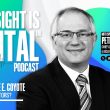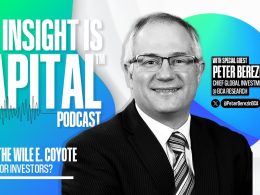Inside Information
Liz Ann Sonders, Senior Vice President, Chief Investment Strategist, Charles Schwab & Co., Inc.,
Brad Sorensen, CFA, Director of Market and Sector Analysis, Schwab Center for Financial Research, and
Michelle Gibley, CFA, Senior Market Analyst, Schwab Center for Financial Research
April 15, 2011
Key points
- Earnings season is ongoing and gives an "insider" look at economic growth. Businesses see and react to changes in the economic environment before the broader macro data shows a clear trend.
- The Federal Reserve has floated some trial balloons about reining in its extremely accommodative policies, the time for which we believe is overdue. Budget issues remain a problem at all levels of government, but likely won’t derail the recovery at this time.
- Despite ongoing debt problems in peripheral European nations, the European Central Bank (ECB) hiked interest rates. While we don’t expect too much damage in the short-term, Europe still faces significant issues that make it more likely to underperform other investable areas of the world.
We are often asked how we can be optimistic on the US stock market when there are so many obvious problems. From the Middle East to Japan, inflation and debt concerns, budget fights and political uncertainty, there is certainly no shortage of things that seemingly could derail the bull market we’re currently experiencing. But that’s the point. All of these items, and more, are already well known by the stock market, which is the ultimate forward looking indicator, meaning the affects of which have likely been largely reflected in stock prices already. It’s important for investors to look beneath the headlines and the “knowns” and look at what may be coming down the road.
We admit some surprise at the resiliency of the stock market over the past month or so. After the much-needed and well anticipated correction we saw during the first part of March, the major indices have recovered those losses and have again moved solidly into positive territory for the year. While dips will undoubtedly continue to occur, which should help keep sentiment grounded, we continue to believe that the general trend of the stock market will be higher. Of course, the ultimate "inside" information is that nobody can predict the future and that diversification remains the key to achieve your financial goals. For a time over the past several years, it seemed to some that the power of diversification was lost as assets largely traded in a “risk on-risk off” scenario. Recently, however, correlations have again started to recede and the beneficial affects of having a diversified portfolio are again reasserting themselves.
Animal spirits returning?
It’s been a while since the “animal spirits” phrase has been tossed around on Wall Street but we believe this could be one of the surprises of 2011. The focus has been on macroeconomic reports, but during this earnings reporting season we believe we can glean some important “insider” views on where the economy is headed. We are especially watching for comments regarding margins as cost pressures have increased with the rise in commodity prices. We’ll also get further information on the level of supply disruption due to the disaster in Japan. Comparisons have gotten more difficult as we continue to progress in the economic expansion, but we believe many of those challenges are already reflected in stock prices, leading to the continued possibility of upside surprises. The aggregate corporate information we have gotten recently points to those animal spirits returning. We’ve started to see business loans increasing, which, along with a jump in merger and acquisition activity, indicate increasing confidence by the corporate sector.
Business loans are turning upward
Source: FactSet, Federal Reserve. As of Apr. 12, 2011.
Additionally, we got a look at the service sector in the form of the ISM Non-Manufacturing Index, which pulled back a bit from a 5-year high but remains at a solid level of 57.3 (anything above 50 indicates expansion). Another area we believe can surprise the market on the upside is the jobs market. Again looking beyond the headline number shows us numerous regional manufacturing surveys with solid employment readings; while a measure of small business confidence, vital to a recovery in the job market, continues to creep higher. Additionally, jobless claims continue to slide generally lower, although we did see a tick up in the most recent reading, and the unemployment rate has now dipped to 8.8%, down 1.3% from its high, and has dropped more in the last four months than any similar time period since 1984. We believe job growth will pick up speed throughout the year as confidence improves and businesses look to keep up with stronger demand. Should this happen, we would likely see a snowball effect where more people working leads to higher demand, which leads to more workers needed to meet that demand, and so on.
Employers are picking up the hiring pace
Source: FactSet, U.S. Labor Dept. As of Apr. 12, 2011.
Fed floats trial balloons
It’s the employment picture that has kept the Federal Reserve from moving off its extremely accommodative stance, in contrast to its European counterpart, which has a single mandate of keeping inflation under control. We have been advocating for some time that the longer the Fed maintains this exceptionally stimulative policy, the more the risks of inflation taking hold rise, leading to the possibility of a more severe response by the Fed than otherwise might be required. And now it seems that some Fed members are starting to head down that path as well. Several Federal Open Market Committee (FOMC) voting members have spoken up recently, suggesting that QE2 could end early (which we think is unlikely), and that rate hikes may be coming before the end of the year (which we believe is more likely).
In contrast to some opinions on the Street, however, we don’t believe these are “rogue” members breaking ranks with Chairman Bernanke, but more of a coordinated effort to prepare the market for the inevitable return to a more normal monetary policy. So far the results have to make the Fed relatively happy. The stock market has continued to move higher despite increased expectations of rate hikes later this year, indicating that stock investors won’t be deterred by a slightly tighter policy in the coming months.
Government budgets remain a mess
Likewise, the stock market seems to be largely ignoring the constant squabbling over budgetary issues in Washington. Indeed the near-term implications of the recent budget deal are likely to be relatively small, with $38.5 billion being cut out of a $3.7 trillion budget. It is the longer-term path about which we are concerned, and the next budget fight over the debt ceiling and 2012 budget is likely to garner more investor attention. It’s quite obvious to both sides of the aisle that the current path of the budget, including Social Security, Medicare, and Medicaid cannot continue for much longer without restructuring. But the question is what are they going to do about it? Proposals continue to be made but it appears the kicking-the-can-down-the-road option is favored by many on the Hill, which will eventually come back to bite the United States. We are hopeful that some progress toward stabilizing the fiscal train wreck can occur, but remain skeptical.
European debt crisis claims Portugal
Pursuing irresponsible fiscal spending policies while also holding high levels of government debt is ultimately unsustainable; it is only a question of timing. Countries in the eurozone have the additional factor of a common currency despite having differing cultures, economies, governments and hence fiscal policies, making economic adjustment very difficult.
Additionally, political differences resulted in the lack of definitive action to address the eurozone sovereign debt overhang and created a crisis of confidence. With Portugal now asking for assistance, let’s review the three countries that have asked for aid:
- Greece: elevated debt-to-GDP and continued negative revisions to its already high deficit drew market attention. The large size of needed deficit reduction, poor history of reform, lax tax collection, and lack of labor market competitiveness remain impediments to recovery. Greece likely cannot grow out of its debt problem, and will probably need a restructuring before 2013, keeping government bond yields elevated.
- Ireland: suffered one of the biggest credit-induced property bubbles in history, resulting in massive bank bailouts. When the government stepped in and guaranteed bank losses, its debt spiraled out of control. Despite the large adjustment needed to return to stabilize debt, Ireland’s growth outlook is the best of the debt-ridden eurozone nations because it initiated deficit reform early, has a good track record of retrenching, and has a more dynamic economy with a skilled manufacturing workforce. Irish debt yields have fallen from high levels after bank stress tests resulted in additional bank capital requirements that appear to be within the amount set aside, and after the new government backed off a threat to force losses on senior bank bondholders.
- Portugal: despite having a lower debt-to-GDP than the group, lack of progress on deficit reduction, high reliance the European Central Bank (ECB) for funding because previous foreign sources of capital disappeared, lack of labor competitiveness and low economic growth, and a non-majority government hurt market confidence. The crisis came to a head after austerity measures were voted down, causing the Prime Minster to resign; and after Portuguese banks balked at buying more government debt heading into funding needs on April 15 and June 15. Portugal may end up with a short-term loan to tie it over until the June 5 election, after which negotiations can be held with the new government.
Market separating European nations
Source: FactSet, iBoxx, Tullett Prebon Information. As of Apr. 12, 2011.
Despite Portugal’s decline, the risk of contagion- where one large failure results in problems elsewhere- may be averted, a dramatic shift versus a year ago. This is because the elephant in the room, Spain, should avoid a bailout, and current measures have ring-fenced problems elsewhere.
Spain has made progress by implementing austerity measures including labor reform and reducing the fiscal deficit, and is addressing bank problems. While Spain’s banks likely need more capital due to possible future property-related losses, they have a bigger cushion to absorb property price declines than Ireland and the United States due to higher loan-to-value ratios.
European Central Bank hikes rates, could result in slowdown
Despite Portugal’s need for funds, the ECB followed through on its “strong vigilance” on inflation by hiking rates in early April. We remain concerned about a rate hike cycle when economic growth in the eurozone remains fragile and the full impact of fiscal austerity is yet to be felt. But the possibility of upward inflation in Germany, the region’s largest economy, suggests the need to prevent inflation expectations from rising, which could feed through to wages and create broad-based inflation.
It is possible the market may be expecting too much tightening by the ECB, as it has priced in three more rate hikes by the ECB in 2011, while the ECB could pause to determine the impact on growth before moving further. We are closely watching credit growth, as well as the impact on consumer spending, as many mortgages, particularly in peripheral nations, are based on variable rates. Additionally, the euro has strengthened on the ECB hike, which could hamper export prospects outside the eurozone for both Germany and Spain.
European stocks appear to be attractively valued. However, outside of companies with high exposure to growth coming from the United States and emerging world, we remain suspect of the ability for European stocks in general to outperform in the face of growth headwinds.
Dollar decline led by relative monetary policy
Thus far this year, the main factor influencing a weakening of the US dollar has been differences in monetary policy between the United States and the ECB. The ECB’s rate hike, while the Fed remains on hold, has resulted in growing interest rate differentials, attracting traders to the euro. Despite the rise in the euro, BCA Research indicates that the 2-year swap spread of rates is above the level seen at end of 2009, when EUR/USD reached 1.50, possibly indicating further upside in the euro, and downside for the US dollar.
However, the US dollar could bounce short-term if the ECB falls short of the market’s expectation of three hikes this year or if strong US growth results in an rate hike earlier than the current market expectation of early 2012. Read more in our currency Q&A and weak dollar articles.
Emerging markets well into tightening cycles
Strong and early economic recoveries in emerging markets resulted in inflation and the need to tighten monetary policy. However, it is possible that the pace of inflation increases is peaking, indicating tightening cycles could slow down and provide a more healthy backdrop for stocks. We point to the performance of Chinese stocks, which have outperformed despite continued increases in bank reserve requirements and rates. We believe emerging market stocks could be poised to outperform due to differing directions of monetary policy, with developed nations either embarking on or close to beginning tightening cycles, while emerging markets could begin to slow rate hikes.
Chinese stocks outperforming despite rate hikes
Source: FactSet, Shanghai Stock Exchange, Standard & Poor's, People's Bank of China. As of Apr. 12, 2011.
Visit www.schwab.com/oninternational more international perspective.
Important Disclosures
The MSCI EAFE® Index (Europe, Australasia, Far East) is a free float-adjusted market capitalization index that is designed to measure developed market equity performance, excluding the United States and Canada. As of May 27, 2010, the MSCI EAFE Index consisted of the following 22 developed market country indexes: Australia, Austria, Belgium, Denmark, Finland, France, Germany, Greece, Hong Kong, Ireland, Israel, Italy, Japan, the Netherlands, New Zealand, Norway, Portugal, Singapore, Spain, Sweden, Switzerland and the United Kingdom.
The MSCI Emerging Markets IndexSM is a free float-adjusted market capitalization index that is designed to measure equity market performance in the global emerging markets. As of May 27, 2010, the MSCI Emerging Markets Index consisted of the following 21 emerging-market country indexes: Brazil, Chile, China, Colombia, the Czech Republic, Egypt, Hungary, India, Indonesia, Korea, Malaysia, Mexico, Morocco, Peru, Philippines, Poland, Russia, South Africa, Taiwan, Thailand and Turkey.
The S&P 500® index is an index of widely traded stocks.
Indexes are unmanaged, do not incur fees or expenses and cannot be invested in directly.
Past performance is no guarantee of future results.
Investing in sectors may involve a greater degree of risk than investments with broader diversification.
International investments are subject to additional risks such as currency fluctuations, political instability and the potential for illiquid markets. Investing in emerging markets can accentuate these risks.
The information contained herein is obtained from sources believed to be reliable, but its accuracy or completeness is not guaranteed. This report is for informational purposes only and is not a solicitation or a recommendation that any particular investor should purchase or sell any particular security. Schwab does not assess the suitability or the potential value of any particular investment. All expressions of opinions are subject to change without notice.
The Schwab Center for Financial Research is a division of Charles Schwab & Co., Inc.
Copyright © Charles Schwab & Co.












